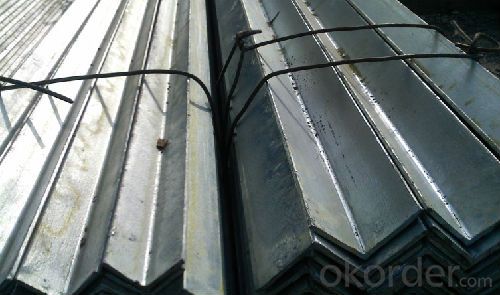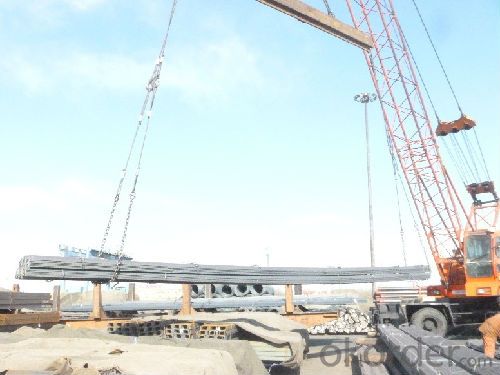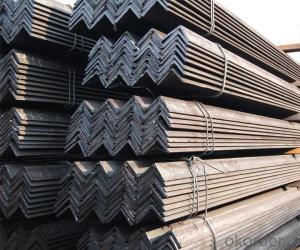Unequal Steel Angle S235jrg Hot Dip Galvanized
- Loading Port:
- Tianjin
- Payment Terms:
- TT or LC
- Min Order Qty:
- 30 m.t.
- Supply Capability:
- 35000 m.t./month
OKorder Service Pledge
OKorder Financial Service
You Might Also Like
Product Description:
OKorder is offering Unequal Steel Angle S235jrg Hot Dip Galvanized at great prices with worldwide shipping. Our supplier is a world-class manufacturer of steel, with our products utilized the world over. OKorder annually supplies products to European, North American and Asian markets. We provide quotations within 24 hours of receiving an inquiry and guarantee competitive prices.
Product Applications:
Unequal Steel Angle S235jrg Hot Dip Galvanized are ideal for structural applications and are widely used in the construction of buildings and bridges, and the manufacturing, petrochemical, and transportation industries.
Product Advantages:
OKorder's Unequal Steel Angle S235jrg Hot Dip Galvanized are durable, strong, and resist corrosion.
Main Product Features:
· Premium quality
· Prompt delivery & seaworthy packing (30 days after receiving deposit)
· Corrosion resistance
· Can be recycled and reused
· Mill test certification
· Professional Service
· Competitive pricing
Product Specifications:
Specification:GB/EN/ASTM/JIS/ S275JR
Grade:A36,SS400,Q235,Q345,ST37,ST52
Zinc thickness:30-100um(200-600g/m2)
Size: from Size 25--Size 100
FAQ:
Q1: Why buy Materials & Equipment from OKorder.com?
A1: All products offered byOKorder.com are carefully selected from China's most reliable manufacturing enterprises. Through its ISO certifications, OKorder.com adheres to the highest standards and a commitment to supply chain safety and customer satisfaction.
Q2: How do we guarantee the quality of our products?
A2: We have established an advanced quality management system which conducts strict quality tests at every step, from raw materials to the final product. At the same time, we provide extensive follow-up service assurances as required.
Q3: How soon can we receive the product after purchase?
A3: Within three days of placing an order, we will begin production. The specific shipping date is dependent upon international and government factors, but is typically 7 to 10 workdays.
Images:



- Q:How do you prevent steel angles from warping?
- There are several measures you can take to prevent steel angles from warping: 1. Proper storage: Ensure that steel angles are stored in a dry and controlled environment to avoid exposure to moisture. Moisture can lead to rust and warping of the angles. Use pallets or racks to store them horizontally to minimize any bending stress. 2. Controlled cooling: During the fabrication process, it is important to have controlled cooling to prevent rapid temperature changes that can induce warping. Gradual cooling methods, such as air cooling or controlled cooling baths, can help avoid thermal stresses and minimize warping. 3. Minimize heat input during welding: When welding steel angles, excessive heat input can cause localized thermal expansion and contraction, leading to warping. Use proper welding techniques, such as shorter welding times, smaller weld beads, and intermittent welding, to minimize heat input and control the temperature gradient. 4. Preheating and post-welding stress relief: For thicker or high-strength steel angles, preheating them before welding can help reduce the risk of warping. Additionally, performing post-welding stress relief heat treatments can help relieve any residual stresses within the material and prevent warping. 5. Proper handling and transportation: When transporting steel angles, ensure that they are adequately supported and secured to avoid any bending or flexing during transit. Avoid dropping or mishandling the angles, as this can introduce structural deformations that lead to warping. By implementing these preventive measures, you can minimize the risk of steel angles warping and ensure their structural integrity for various applications.
- Q:Can steel angles be used in residential construction?
- Yes, steel angles can be used in residential construction. Steel angles are commonly used as structural elements in residential buildings for various applications, such as supporting roof trusses, reinforcing walls, framing doorways, and constructing balconies. They provide strength, durability, and stability to the structure, making them a suitable choice for residential construction projects.
- Q:What are the safety considerations when working with steel angles?
- When working with steel angles, it is crucial to prioritize safety. Some key safety considerations include wearing appropriate personal protective equipment (PPE) such as gloves, safety glasses, and steel-toed boots to protect against potential injuries. Additionally, it is important to handle steel angles with care and use proper lifting techniques to avoid strain or muscle injuries. Adequate training and knowledge of the equipment being used, such as angle grinders or welding tools, is essential to prevent accidents. Finally, maintaining a clean and organized work area can help minimize tripping hazards and ensure a safer working environment.
- Q:How do steel angles contribute to the overall durability of a structure?
- Steel angles contribute to the overall durability of a structure by providing structural support and reinforcement. They are commonly used in construction to add strength and stability to various components of a building, such as beams, columns, and frames. The L-shaped design of steel angles allows them to effectively distribute and transfer loads, reducing the risk of deformation, collapse, or failure. Additionally, their high tensile strength and resistance to bending and twisting make them ideal for withstanding heavy loads, seismic forces, and adverse environmental conditions, thus enhancing the durability and longevity of the structure.
- Q:What are the different types of steel angles used in construction?
- There are several types of steel angles commonly used in construction, including equal angles, unequal angles, L-shaped angles, and T-shaped angles. These angles are used to provide structural support, reinforcement, and stability in various building applications.
- Q:Can steel angles be used for manufacturing support brackets?
- Yes, steel angles can be used for manufacturing support brackets. Steel angles are commonly used in construction and manufacturing industries due to their strength and durability. They provide excellent support and structural integrity, making them ideal for creating support brackets. Steel angles are available in various sizes and thicknesses, allowing for customization based on the specific requirements of the bracket. Additionally, steel angles can be easily welded, drilled, and machined to fit the desired specifications, making them a versatile choice for manufacturing support brackets.
- Q:What is the bending capacity of a steel angle?
- The bending capacity of a steel angle refers to its ability to withstand bending or flexing without breaking or deforming excessively. It is a measure of the angle's structural strength and is typically determined by factors such as the dimensions and thickness of the angle, the type of steel used, and any additional reinforcements or supports present. The bending capacity is usually expressed in terms of the maximum amount of load or stress that the angle can endure before it reaches its yield point, which is the point at which it permanently deforms. The bending capacity of a steel angle can vary widely depending on these factors, and it is crucial to consider this capacity when designing and constructing structures that utilize steel angles to ensure their structural integrity and safety.
- Q:Can steel angles be used for support columns?
- Yes, steel angles can be used for support columns. Steel angles offer excellent structural support and can be used to provide stability and strength to support columns in various construction and engineering applications. The angled shape of the steel angles helps distribute the load and provide additional rigidity to the support columns.
- Q:What is the maximum load a steel angle can support?
- The load capacity of a steel angle depends on various factors including its dimensions, the type and grade of steel used, and the method of support. Steel angles are generally known for their strength and ability to bear heavy loads. They are commonly used in construction and structural applications to provide support and stability to different structures. To determine the maximum load that a specific steel angle can support, it is necessary to refer to engineering tables or reference materials that provide load capacity data for different steel angles. These resources take into account factors such as the angle's length, width, and thickness, the type of steel used (e.g., mild steel or high-strength steel), and the method of support (e.g., cantilever or simply supported). It is important to highlight that determining the maximum load a steel angle can bear typically involves conducting tests in a controlled environment to ensure safety and reliability. These tests involve gradually increasing the load applied to the angle until it reaches its maximum load-bearing capacity or fails. The results of these tests are used to establish load capacity guidelines for engineers and builders. Therefore, without specific information regarding the dimensions, type of steel, and method of support, it is not possible to provide an exact maximum load value for a steel angle. It is recommended to consult relevant engineering references, structural engineers, or manufacturers to obtain accurate load capacity information for a specific steel angle.
- Q:What are the considerations for selecting the appropriate steel angle thickness?
- There are several considerations for selecting the appropriate steel angle thickness. Firstly, the load-bearing capacity of the steel angle must be taken into account. The thickness should be chosen based on the expected weight and stress that will be placed on the angle. Additionally, the length and span of the angle should be considered, as longer and wider spans may require thicker steel angles to provide adequate support. Environmental factors, such as exposure to corrosive substances or extreme temperatures, should also be evaluated to select a thickness that can withstand these conditions. Finally, budget constraints and cost-effectiveness may influence the choice of steel angle thickness, as thicker angles are generally more expensive.
1. Manufacturer Overview |
|
|---|---|
| Location | |
| Year Established | |
| Annual Output Value | |
| Main Markets | |
| Company Certifications | |
2. Manufacturer Certificates |
|
|---|---|
| a) Certification Name | |
| Range | |
| Reference | |
| Validity Period | |
3. Manufacturer Capability |
|
|---|---|
| a)Trade Capacity | |
| Nearest Port | |
| Export Percentage | |
| No.of Employees in Trade Department | |
| Language Spoken: | |
| b)Factory Information | |
| Factory Size: | |
| No. of Production Lines | |
| Contract Manufacturing | |
| Product Price Range | |
Send your message to us
Unequal Steel Angle S235jrg Hot Dip Galvanized
- Loading Port:
- Tianjin
- Payment Terms:
- TT or LC
- Min Order Qty:
- 30 m.t.
- Supply Capability:
- 35000 m.t./month
OKorder Service Pledge
OKorder Financial Service
Similar products
New products
Hot products
Related keywords




























